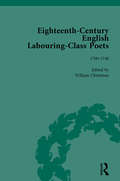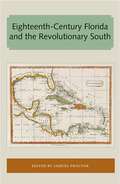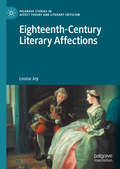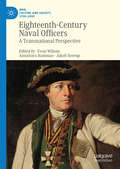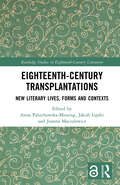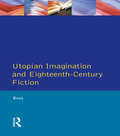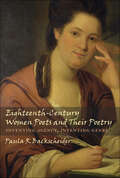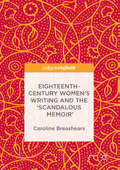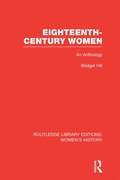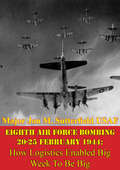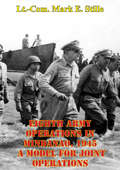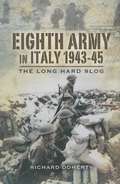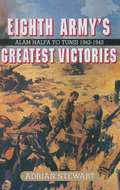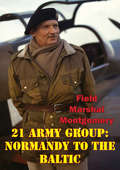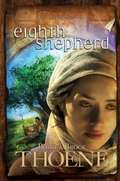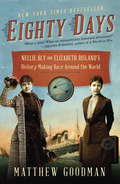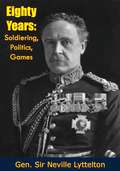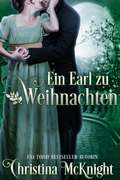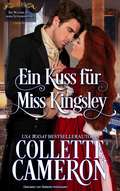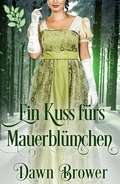- Table View
- List View
Eighteenth-Century English Labouring-Class Poets, vol 1
by John Goodridge Simon Kövesi David Fairer Tim Burke William ChristmasPoets of labouring class origin were published in Britain in the 18th and 19th centuries. Some were popular and important in their day but few are available today. This is a collection of some of those poems from the 18th century.
Eighteenth-Century Environmental Humanities (Transits: Literature, Thought & Culture, 1650-1850)
by Shelby Johnson Jeremy Chow Elliot Patsoura Annette Hulbert Adam Sweeting Mariah Crilley Claire Campbell Jason Payton Matt Duquès Ami Yoon Christopher Allan Black Kate ScarthThis groundbreaking new volume unites eighteenth-century studies and the environmental humanities, showcasing how these fields can vibrantly benefit one another. In eleven chapters that engage a variety of eighteenth-century texts, contributors explore timely themes and topics such as climate change, new materialisms, the blue humanities, indigeneity and decoloniality, and green utopianism. Additionally, each chapter reflects on pedagogical concerns, asking: How do we teach eighteenth-century environmental humanities? With particular attention to the voices of early-career scholars who bring cutting-edge perspectives, these essays highlight vital and innovative trends that can enrich both disciplines, making them essential for classroom use.
Eighteenth-Century Florida and the Revolutionary South (Florida and the Caribbean Open Books Series)
by Samuel ProctorThe books in the Florida and the Caribbean Open Books Series demonstrate the University Press of Florida’s long history of publishing Latin American and Caribbean studies titles that connect in and through Florida, highlighting the connections between the Sunshine State and its neighboring islands. Books in this series show how early explorers found and settled Florida and the Caribbean. They tell the tales of early pioneers, both foreign and domestic. They examine topics critical to the area such as travel, migration, economic opportunity, and tourism. They look at the growth of Florida and the Caribbean and the attendant pressures on the environment, culture, urban development, and the movement of peoples, both forced and voluntary. The Florida and the Caribbean Open Books Series gathers the rich data available in these architectural, archaeological, cultural, and historical works, as well as the travelogues and naturalists’ sketches of the area in prior to the twentieth century, making it accessible for scholars and the general public alike. The Florida and the Caribbean Open Books Series is made possible through a grant from the National Endowment for the Humanities and the Andrew W. Mellon Foundation, under the Humanities Open Books program.
Eighteenth-Century Literary Affections (Palgrave Studies in Affect Theory and Literary Criticism)
by Louise JoyThis book assesses the mediating role played by 'affections' in eighteenth-century contestations about reason and passion, questioning their availability and desirability outside textual form. It examines the formulation and idealization of this affective category in works by Isaac Watts, Lord Shaftesbury, Mary Hays, William Godwin, Helen Maria Williams, and William Wordsworth. Part I outlines how affections are invested with utopian potential in theology, moral philosophy, and criticism, re-imagining what it might mean to know emotion. Part II considers attempts of writers at the end of the period to draw affections into literature as a means of negotiating a middle way between realism and idealism, expressivism and didacticism, particularity and abstraction, subjectivity and objectivity, femininity and masculinity, radicalism and conservatism, and the foreign and the domestic.
Eighteenth-Century Naval Officers: A Transnational Perspective (War, Culture and Society, 1750 –1850)
by Evan Wilson AnnaSara Hammar Jakob SeerupThis book surveys the lives and careers of naval officers across Europe at the height of the age of sail. It traces the professionalization of naval officers by exploring their preparation for life at sea and the challenges they faced while in command. It also demonstrates the uniqueness of the maritime experience, as long voyages and isolation at sea cemented their bond with naval officers across Europe while separating them from landlubbers. It depicts, in a way no previous study has, the parameters of their shared experiences—both the similarities that crossed national boundaries and connected officers, and the differences that can only be seen from an international perspective.
Eighteenth-Century Thing Theory in a Global Context: From Consumerism to Celebrity Culture
by Ileana Baird Christina IonescuExploring Enlightenment attitudes toward things and their relation to human subjects, this collection offers a geographically wide-ranging perspective on what the eighteenth century looked like beyond British or British-colonial borders. To highlight trends, fashions, and cultural imports of truly global significance, the contributors draw their case studies from Western Europe, Russia, Africa, Latin America, and Oceania. This survey underscores the multifarious ways in which new theoretical approaches, such as thing theory or material and visual culture studies, revise our understanding of the people and objects that inhabit the phenomenological spaces of the eighteenth century. Rather than focusing on a particular geographical area, or on the global as a juxtaposition of regions with a distinctive cultural footprint, this collection draws attention to the unforeseen relational maps drawn by things in their global peregrinations, celebrating the logic of serendipity that transforms the object into some-thing else when it is placed in a new locale.
Eighteenth-Century Transplantations: New Literary Lives, Forms and Contexts (Routledge Studies in Eighteenth-Century Literature)
by Jakub Lipski Joanna Maciulewicz Anna Paluchowska-MessingThis collection studies eighteenth-century British literature as enmeshed within a dynamic intercultural traffic, participating in the import and export of literary and cultural forms. Eighteenth-Century Transplantations places this transcultural circulation at the centre of attention and presents its products in a unique configuration. Literary transplants into the British context, out of it, and their transmedial afterlives are set together in order to showcase the mechanisms of such cultural commerce. The term 'transplantation', borrowed from medical and horticultural discourses and evocative of eighteenth-century experiments in gardening, is offered here as a useful kinetic model to conceptualize the diverse practices involved in relocating a literary text into a new cultural environment.
Eighteenth-Century Utopian Fiction (Studies In Eighteenth and Nineteenth Century Literature Series)
by Christine ReesUtopian fiction was a particularly rich and important genre during the eighteenth century. It was during this period that a relatively new phenomenon appeared: the merging of utopian writing per se with other fictional genres, such as the increasingly dominant novel. However, while early modern and nineteenth and twentieth century utopias have been the focus of much attention, the eighteenth century has largely been neglected. Utopian Imagination and Eighteenth Century Fiction combines these major areas of interest, interpreting some of the most fascinating and innovative fictions of the period and locating them in a continuing tradition of utopian writing which stretches back through the Renaissance to the Ancient World.Begining with a survey of the recurrent topics in utopian writing - power structures in the state, money, food, sex, the role of women, birth, education and death - the book brings together canonical eighteenth century texts countaining powerful utopian elements, such as Robinson Crusoe, Gulliver's Travels and Rasselas, and less familiar works, to examine the reworking of these topics in a new context. The unfamiliar texts, including Gaudentio di Lucca, are described in detail to give students an idea of relevant material across a broad area. A section is devoted specifically to women writes, an area which has become the focus of attention. The mixture of texts provides a useful cross-reference for students tackling the subject from various perspectives and the comprehensive bibliography provides a valuable tool for those with general or specific interests
Eighteenth-Century Women Poets and Their Poetry: Inventing Agency, Inventing Genre
by Paula R. Backscheider“Our sense of eighteenth-century poetic territory is immeasurably expanded by [this] excellent historical and cultural” study of UK women poets of the era (Cynthia Wall, Studies in English Literature).This major work offers a broad view of the writing and careers of eighteenth-century women poets, casting new light on the ways in which poetry was read and enjoyed, on changing poetic tastes in British culture, and on the development of many major poetic genres and traditions.Rather than presenting a chronological survey, Paula R. Backscheider explores the forms in which women wrote and the uses to which they put those forms. Considering more than forty women in relation to canonical male writers of the same era, she concludes that women wrote in all of the genres that men did but often adapted, revised, and even created new poetic kinds from traditional forms.Backscheider demonstrates that knowledge of these women’s poetry is necessary for an accurate and nuanced literary history. Within chapters on important verse forms, she sheds light on such topics as women’s use of religious poetry to express ideas about patriarchy and rape; the important role of friendship poetry; same-sex desire in elegy by women as well as by men; and the status of Charlotte Smith as a key figure of the long eighteenth century, not only as a Romantic-era poet.Co-Winner, James Russell Lowell Prize, Modern Language Association
Eighteenth-Century Women's Writing and the 'Scandalous Memoir'
by Caroline BreashearsThis book contributes to the literary history of eighteenth-century women's life writings, particularly those labeled "scandalous memoirs. " It examines how the evolution of this subgenre was shaped partially by several innovative memoirs that have received only modest critical attention. Breashears argues that Madame de La Touche's Apologie and her friend Lady Vane's Memoirs contributed to the crystallization of this sub-genre at mid-century, and that Lady Vane's collaboration with Tobias Smollett in The Adventures of Peregrine Pickle resulted in a brilliant experiment in the relationship between gender and genre. It demonstrates that the Memoirs of Catherine Jemmat incorporated influential new strategies for self-justification in response to changing kinship priorities, and that Margaret Coghlan's Memoirs introduced revolutionary themes that created a hybrid: the political scandalous memoir. This book will therefore appeal to scholars interested in life writing, women's history, genre theory, and eighteenth-century British literature.
Eighteenth-century Women: An Anthology (Routledge Library Editions: Women's History)
by Bridget HillWhen it was first published in 1984, this book filled an acknowledged gap in the social history of the period and made available hitherto inaccessible sources. The work draws on newspapers and journals, memoirs, diaries, courtesy books, county surveys and records, but also on the literature of the period, its novels, poetry and plays. It examines the role assigned to women in eighteenth-century society and the education thought fitting to perform it. It looks at attitudes to courtship and marriage, chastity and sexual passion. It explores the role of women as wives and mothers, as spinsters and widows, and focuses on the living and working experience of women whether in the home, agriculture, industry or domestic service. It contrasts the expectations of the rich and the poor, the leisured lady and the underpaid female agricultural labourer, the unmarried mother and the prostitute.
Eighth Air Force Bombing 20-25 February 1944: How Logistics Enabled Big Week To Be Big
by Major Jon M. Sutterfield USAFEighth Air Force (8AF) conducted the US's first thousand-bomber raids against Germany in February 1944--recorded in history as Big Week. Until that time the USAAF was not able to concentrate such firepower on the enemy in such a short period of time. It took much effort to make Big Week "big" covering the spectrum of planning and execution activities dating back to the end of World War I that were adapted and flexed to be successful in a different context. Indeed, the depth and breadth of the preparations required to successfully execute Big Week on the scale intended is deserving of a closer examination.Leadership from President Roosevelt to first line supervisors influenced 8AF logistics before February 1944. Major General Hugh J. Knerr was the one man that stood out as the champion of USAAF logistics. He influenced the concept of logistical operations in the ETO and, more specifically, put logistics on a level of importance equal to that of operations within the United States Strategic Air Forces (USSTAF). He synchronized logistics with operations and strove for constant improvement by making organizational and process changes aimed at increasing logistical responsiveness, effectiveness, and efficiency.The British provided tremendous host nation support including construction of new airfields, skilled and unskilled labor support, supply items, and transportation. The British host nation support 8AF received far surpassed what a cursory review of World War II history leads one to believe and serves as a model for US-led coalition operations in the 21st century. The US Merchant Marine and US Navy provided sealift of goods from the stateside depots to the theater. The US Army provided supply support of common items and Air Service Command (ASC) provided technical and supply support. Last, but not least, both civil servants and civilian contractors provided depot maintenance and in-theater technical support.
Eighth Army Operations In Mindanao, 1945 A Model For Joint Operations
by Colonel Joseph G. Terry Jr.While amphibious operations have historically straddled single service prerogatives and had been conspicuously avoided prior to World War II, in the Pacific area of operations during World War II such operations were abundant, decisive and generally regarded as models of joint service cooperation. Under the legendary General Douglas MacArthur, the Philippine Campaign in 1944-45 was especially noteworthy as a model of a single flexible strategy, unity of command, and joint service cooperation. Yet forty-five years later, our national military experience in joint planning and operations has appeared to regress. The recent Goldwater-Nichols Department of Defense Reorganization Act of 1986, however, has elevated service interest in joint planning and operations. This study briefly discusses the Mindanao Operation (March-July 1945), one of several operations within the Philippine Campaign. The study focuses on the impact of existing joint doctrine on the planning, coordination and execution of operations and evidence of joint action to solve some specific and unique challenges encountered within the operation. A summary of the Mindanao operation and appropriate comments on its applicability as a model for today's joint operations complete this study.
Eighth Army in Italy, 1943-45: The Long Hard Slog
by Richard DohertyEighth Army, Britain's most famous field army of the twentieth century, landed in Italy in September 1943 and fought continously until the defeat of the Germans in early-May 1945. This book studies the experience of Eighth Army in the Italian campaign, examining how a force accustomed to the open spaces of North Africa adjusted to the difficult terrain of Italy where fighting became much more a matter for the infantry than for the armour. It also compares the qualities of the commanders of Eighth Army in Italy: Montgomery; Leese and, finally, McCreery. The book uses official records at various levels, personal accounts - some never before published - and published material to present a picture of an army that, although defined as British, was one of the war's most cosmopolitan formations. Its soldiers came from the UK, Canada, India, Ireland, Nepal, New Zealand, Poland and South Africa as well as from Palestine - the Jewish Brigade - and from Italy itself.
Eighth Army's Greatest Victories: Alam Halfa to Tunis 1942–1943
by Adrian TurnerTo read many accounts, it would appear that the Eighth Army's victory at El Alamein was quickly followed by its triumphant arrival at Tunis. Adrian Turner, the experienced authority on the period, redresses the imbalance by describing brilliantly the progress of this legendary fighting force and describing the ferocity of such battles as that for the Mareth Line. The author deftly handles strategic level thinking, the tactical battles and individual contributions. Aviation readers will be thrilled by recognition of the Desert Air Force's contribution, too often neglected.
Eighth Army: El Alamein To The River Sangro [Illustrated Edition] (Memoirs Of Field Marshal Montgomery #2)
by Field Marshal Viscount Bernard Law Montgomery of Alamein KG GCB DSO PC[Illustrated with 16 highly detailed maps of the actions]Field Marshal Montgomery commanded the Eighth Army from 13th August 1942 until the 31st December 1943, and the 21st Army Group from 1st January 1944 until the German surrender on the 5th May, 1945. Whilst in command of the British Army of the Rhine, in occupation of Germany, shortly after the end of the Second World War Montgomery set out to record the exploits and victories of the troops under his command.Both this volume and its companion volume, Normandy to the Rhine, are superb examples of military history as presented by one of the greatest generals to command victorious armies in the field. The texts are taken from his personal war diaries and are distinguished by his incisive style. The whole strategy and course of these two campaigns are presented to the reader with great clarity and accuracy.El Alamein to the River Sangro is as he himself writes '... an authoritative account of the activities of the Eighth Army in the days of its greatest, successes'. El Alamein was the turning point in the war: from that momentous battle the tide against Germany turned. During the time the Eighth Army was commanded by Monty it lost not a single action, and when Monty was transferred to Europe in December 1943, Winston Churchill wrote to him: 'The immortal march of the Eighth Army from the gates of Cairo along the African shore, through Sicily, has now carried its ever victorious soldiers far into Italy towards the gates of Rome. The scene changes and vastly expands. A great task accomplished gives place to a greater, in which the same unfailing spirit will win for all true men a full and glorious reward.'
Eighth Shepherd (A. D. Chronicles #8)
by Bodie Thoene Brock ThoeneAfter Yeshua of Nazareth has raised his friend Elazar from the dead, news of Yeshua travels fast and the Sanhedrin begin their plot to kill him. Despite the danger, Yeshua and his followers begin the journey to Jerusalem for Passover. Meanwhile, Zachai the tax collector (Zacchaeus), the most hated man in Judea, longs to be a part of the Jewish society that he has been cut off from due to his profession. He falls into despair, believing God cant hear him and that he will always be alone. Simona, a leper who was healed by Yeshua but remains cut off from society to live in the sycamore grove, shows compassion to Zachai and tells him of Yeshua. Zachai begins his quest to find Yeshua in hopes that this man can heal his heart, just as he healed Simonas leprosy.
Eighty Days: Nellie Bly and Elizabeth Bisland's History-making Race Around the World
by Matthew GoodmanOn November 14, 1889, Nellie Bly, the crusading young female reporter for Joseph Pulitzer's World newspaper, left New York City by steamship on a quest to break the record for the fastest trip around the world. Also departing from New York that day--and heading in the opposite direction by train--was a young journalist from The Cosmopolitan magazine, Elizabeth Bisland. Each woman was determined to outdo Jules Verne's fictional hero Phileas Fogg and circle the globe in less than eighty days. The dramatic race that ensued would span twenty-eight thousand miles, captivate the nation, and change both competitors' lives forever. The two women were a study in contrasts. Nellie Bly was a scrappy, hard-driving, ambitious reporter from Pennsylvania coal country who sought out the most sensational news stories, often going undercover to expose social injustice. Genteel and elegant, Elizabeth Bisland had been born into an aristocratic Southern family, preferred novels and poetry to newspapers, and was widely referred to as the most beautiful woman in metropolitan journalism. Both women, though, were talented writers who had carved out successful careers in the hypercompetitive, male-dominated world of big-city newspapers. Eighty Days brings these trailblazing women to life as they race against time and each other, unaided and alone, ever aware that the slightest delay could mean the difference between victory and defeat. A vivid real-life re-creation of the race and its aftermath, from its frenzied start to the nail-biting dash at its finish, Eighty Days is history with the heart of a great adventure novel. Here's the journey that takes us behind the walls of Jules Verne's Amiens estate, into the back alleys of Hong Kong, onto the grounds of a Ceylon tea plantation, through storm-tossed ocean crossings and mountains blocked by snowdrifts twenty feet deep, and to many more unexpected and exotic locales from London to Yokohama. Along the way, we are treated to fascinating glimpses of everyday life in the late nineteenth century--an era of unprecedented technological advances, newly remade in the image of the steamship, the railroad, and the telegraph. For Nellie Bly and Elizabeth Bisland--two women ahead of their time in every sense of the word--were not only racing around the world. They were also racing through the very heart of the Victorian age.Advance praise for Eighty Days "What a story! What an extraordinary historical adventure!"--Amanda Foreman, author of A World on Fire "Vividly imagined and gorgeously detailed, Eighty Days recounts the exhilarating journey of two pioneering women, Nellie Bly and Elizabeth Bisland, as they race around the globe. Matthew Goodman has crafted a fun, fast, page-turning action-adventure that will make you wish you could carry their bags."--Karen Abbott, author of American Rose "What a delight to circumnavigate the globe with pioneering journalists Nellie Bly and Elizabeth Bisland. The two women carve out an adventurous path in a constrained Victorian world that cares as much about their marriage prospects and the number of trunks they pack as about their trailblazing career aspirations. Matthew Goodman's lively writing and detailed research bring the story of these two remarkable women to life as they race around the world, full steam ahead, giving us an intimate look at a late-nineteenth-century world that is suddenly shrinking in the face of rapid technological change. Only one of these two remarkable women can win the race around the world, but the reader of this fascinating tale will be certain of a reward."--Elizabeth Letts, author of The Eighty-Dollar Champion
Eighty Years of Archaeology at Liangzhu (Liangzhu Civilization)
by Yefei ZhuThis book summary introduces the key research findings, exploration and excavation works carried out during the 80 years of archaeological endeavours entirely devoted to Liangzhu historical sites. Xingeng SHI first discovered of neolithic remains in 1936, followed along with designation of official name which was given by Nai XIA in 1959. Another perspective also indicates finding of several pieces of black pottery at the Qipanfen historical site in the year 1936 till the latest over 1200 pieces of jades unearthed in Fanshan cemetery in the year 1986. A brief timeline history as listed above has been demonstrated that the great efforts and sacrifices had made by earlier generations of archaeologist in Liangzhu as witness to explore the origin of the 5000 years of Chinese civilization. The public is more familiar with Fanshan cemetery and Liangzhu ancient city as well as precious cultural relics such as jade Cong and jade Yue. Through the 80 years of archaeological ruins of Liangzhu field works that performed, in fact, there are existing historical monuments for example as places of Zhucundou and Wujiabu and ordinary objects include pottery and stoneware, they remain unknown to the general public. This book offers the readers a unique perspective, is the first research to focus on the Liangzhu Archaeological Team members’ viewpoint of exploring the perceived value of an extraordinary experience and compare it with an ordinary experience behind the 80 years of archaeology of the Liangzhu site.
Eighty Years: Soldiering, Politics, Games
by Gen. Sir Neville LytteltonBegun in 1914 and first published in 1927, these are the memoirs of General Sir Neville Gerald Lyttelton, a British Army officer who served, in the Sudan, Ireland and most notably the Second Boer War. He draws upon his reminiscences with the aid of correspondence with various members of his family and from his diary entries dating back as far as 1873.A fascinating military history read!
Ein Earl zu Weihnachten
by Christina McKnightEIN MANN AUF DER FLUCHT VOR DER VERGANGENHEIT ... Als Silas Anson von seinem Vater, an den er sich nicht erinnern kann, die Grafschaft Lichfield erbt, hat er nur ein Ziel: für seine Geschwister zu sorgen. Um das zu erreichen, muss er zwei Dinge tun: einen Weg finden, um das Anwesen aus der Armut herauszuholen, und sich der Unterstützung seiner mächtigen Familie versichern - eine Familie, die seine Mutter vor vielen Jahren im Stich ließ. Eine arrangierte Ehe mit der Tochter des Marquess of Blandford scheint der perfekte Weg, beides zu erreichen und ihm ein normales, glückliches Leben zu ermöglichen. ... BRAUCHT EINE FRAU, DIE IN DIE ZUKUNFT SEHEN KANN. Nur ist Lady Mallory Hughes kaum die gewöhnliche Debütantin, mit der er rechnet. Zusammen mit einer ordentlichen Mitgift hat sie auch eine Gabe geerbt, die in ihrer Familie immer wieder auftaucht: sie kann in die Zukunft sehen. Jahrelang hat ihre Familie sie vor der Gesellschaft verborgen gehalten, aus Furcht, dass sie Schande über die Blandfords bringen könnte. Wenn sie sich die Chance auf ein unabhängiges Leben - und auf Liebe - erhalten will, muss sie diese Woche überstehen, ohne sich und ihre Visionen bei Silas zu verraten. Doch als Mallory Silas versehentlich berührt, sieht sie seinen Tod. Mit Silas' Leben in Gefahr, wie kann Mallory ihn retten, ohne über ihre Gabe zu reden und dadurch ihre Chancen auf eine gemeinsame Zukunft zu zerstören?
Ein Jahrhundert Grundschule: Zur Geschichte der Basisinstitution des deutschen Bildungssystems
by Susanne Miller Margarete Götz Michaela VogtIn dem Buch wird in thematisch differenzierter Weise die 100-jährige Geschichte der Grundschule als Basisinstitution des deutschen Schulsystems rekonstruiert. Analysiert werden im diachronen Verlauf die bildungstheoretische Fundierung der Grundschularbeit, ihr pädagogisch-didaktisches wie ihr institutionelles Profil, weiterhin die Ausbildungs- und Berufsspezifika der Grundschullehrkräfte sowie am Beispiel des Sachunterrichts eine curriculare Besonderheit des Grundschulunterrichts. Die jeweiligen Analysebefunde werden in ihrer Bedeutung für die gegenwärtige Arbeit und die zukünftige Entwicklung der Grundschule reflektiert.
Ein Klagelied für Melusine: Ein mittelalterliches Märchen
by Claire DelacroixMelusine ist dazu verflucht, jede Woche einen Tag lang die Gestalt zu wechseln und sie weiß, dass nur die Liebe sie befreien kann. Als sie Raymond begegnet, einem gut aussehenden Ritter, der dringend Hilfe braucht, die nur sie ihm geben kann, glaubt sie, dass ihre Chance gekommen ist. Sie schwört ihm eine treue Ehefrau zu sein und seine Liebe zu verdienen, auch wenn sie ihren Fluch geheim halten will. Als ihre glückliche Verbindung durch ein Unglück auf die Probe gestellt wird, schwört Raymond, dem eifersüchtigen Geflüster der Anderen das Gegenteil zu beweisen. Wird er in Versuchung geraten, sein Versprechen gegenüber Melusine zu brechen, um die Wahrheit herauszufinden? Und wird seine Liebe zu seiner Braut überleben, wenn ihr Geheimnis gelüftet wird?
Ein Kuss für Miss Kingsley: Ein liebreizender bis pikanter, zeitloser Liebesroman (Ein Walzer mit einem Schwerenöter #1)
by Collette CameronKann ein wunderschönes Fräulein der Liebe wieder vertrauen? Besonders bei dem Schurken, der ihr das erste Mal das Herz gebrochen hatte? Olivia Kingsley hatte nicht damit gerechnet, dass ihr Herz im Sturm erobert werden würde und sie einen Heiratsantrag nur zwei Wochen nach Beginn ihrer ersten Saison zu erhält. Jedoch, ein herrlicher Tanz mit Allen Wimpleton, Erbe eines Viscountstitels, und ihre Zukunft ist besiegelt. So denkt sie jedenfalls, bis ihr exzentrischer Vater plötzlich ankündigt, dass er mit der gesamten Familie für ein Jahr in die Karibik geht. Mit dem Wissen, dass ihr Vater wahrscheinlich seine Bitte um Olivias Hand ausschlagen wird, bittet Allen sie, mit ihm durchzubrennen. Sie weigert sich, da sie erst kürzlich ihre Mutter verloren hat und sich Sorgen darüber macht, dass ihr Vater ebenfalls erkrankt ist – wobei er darauf besteht, dass dies ein Geheimnis bleiben muss. Verzweifelt über ihren Weggang und nichts ahnend vom schlechten Gesundheitszustand ihres Vaters, zweifelt Allen an ihrer Liebe für ihn und besteht törichterweise darauf, dass sie sich entscheiden muss – zwischen ihm oder ihrem Vater. Todunglücklich über Allens Herzlosigkeit, aber dankbar dafür, dass er seine wahre Natur vor ihrer Hochzeit offenbart hat, kehrt Olivia ihrer Liebe den Rücken zu. Aus dem einen Jahr werden drei, genügend Zeit für ein gebrochenes Herz, um zu heilen, und nachdem ihr Vater gestorben ist, kehrt Olivia nach England zurück. Auf einem Ball Allen gegenüberstehend, erkennt sie, dass sie ihn nie aus ihrem Herzen gelöscht hat. Aber können sie ihre Vergangenheit und alte Wunden hinter sich lassen, um die Liebe wieder zu finden? Oder hat Allen bereits eine andere gefunden?
Ein Kuss fürs Mauerblümchen
by Dawn Brower Kim HenryHast du je von einer Hochzeit zum Weihnachtsfest geträumt? Ein Mauerblümchen zu sein, hat nie besser ausgesehen, aber auch das wird Lady Juliette Brooks nicht retten. Ihr Vater hat eine Ehe mit einem gewalttätigen Mann für sie arrangiert. Ihr bleibt nur eine einzige Wahl – den Herzog von Kissinger zu zwingen, ein Versprechen zu ehren, das er ihr vor langer Zeit gegeben hat. Grayson Abbot, der Herzog von Kissinger, hat nicht vor, Lady Juliette zu ehelichen. Genaugenommen gibt es keine einzige Lady in der Gesellschaft, die er zu heiraten wünscht. Doch die Tatsache, dass er Juliette einst ein Versprechen gab, lässt sich nicht verleugnen, und er ist kein Mann, der Schwüre bricht. Widerstrebend willigt er ein, mit ihr zusammen durchzubrennen. Mitten in der Weihnachtszeit brechen sie zu ihrem Abenteuer auf. Auf der Reise nach Schottland kommt es zu Verzögerungen, es ist eisig kalt, und sie entdecken eine Freundschaft wieder, die sie fast vergessen hatten. Wird Juliette endlich herausfinden, wie ein Kuss sich anfühlt, und wird sie das Herz des Herzogs gewinnen
